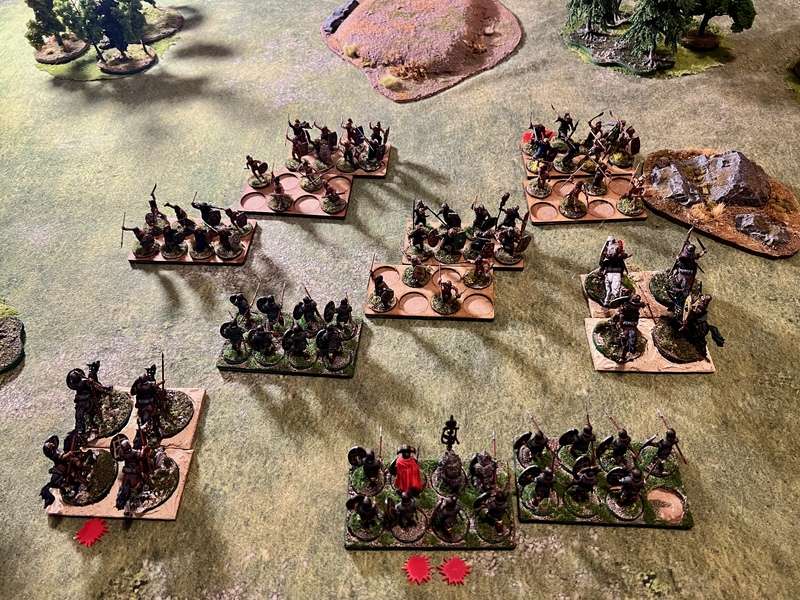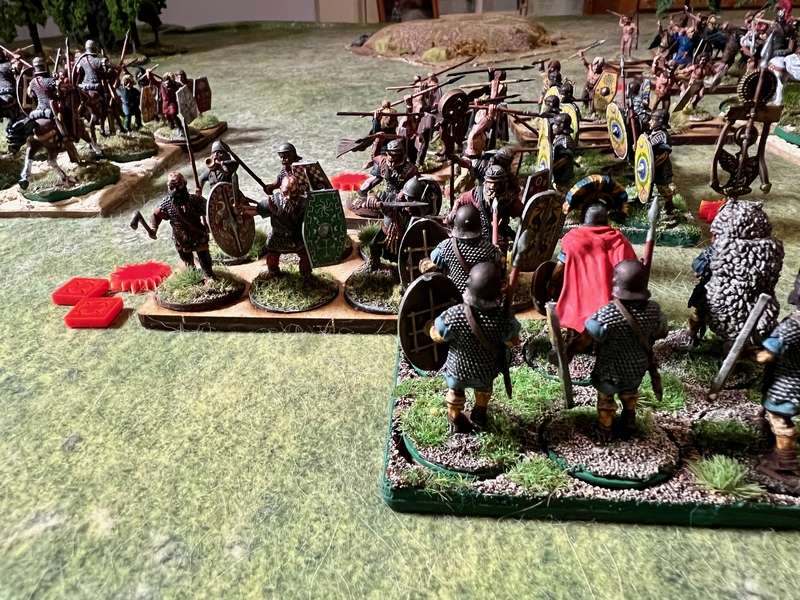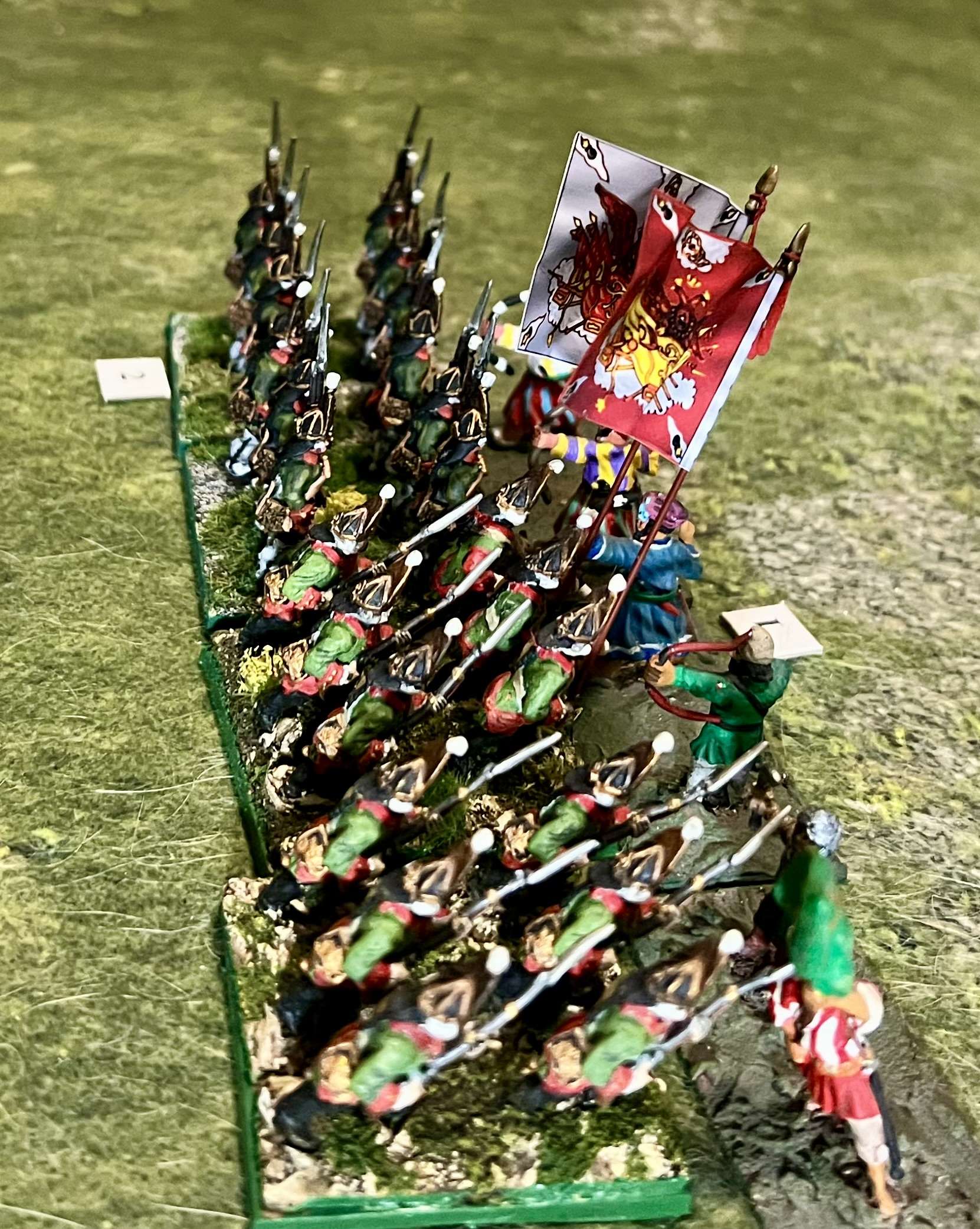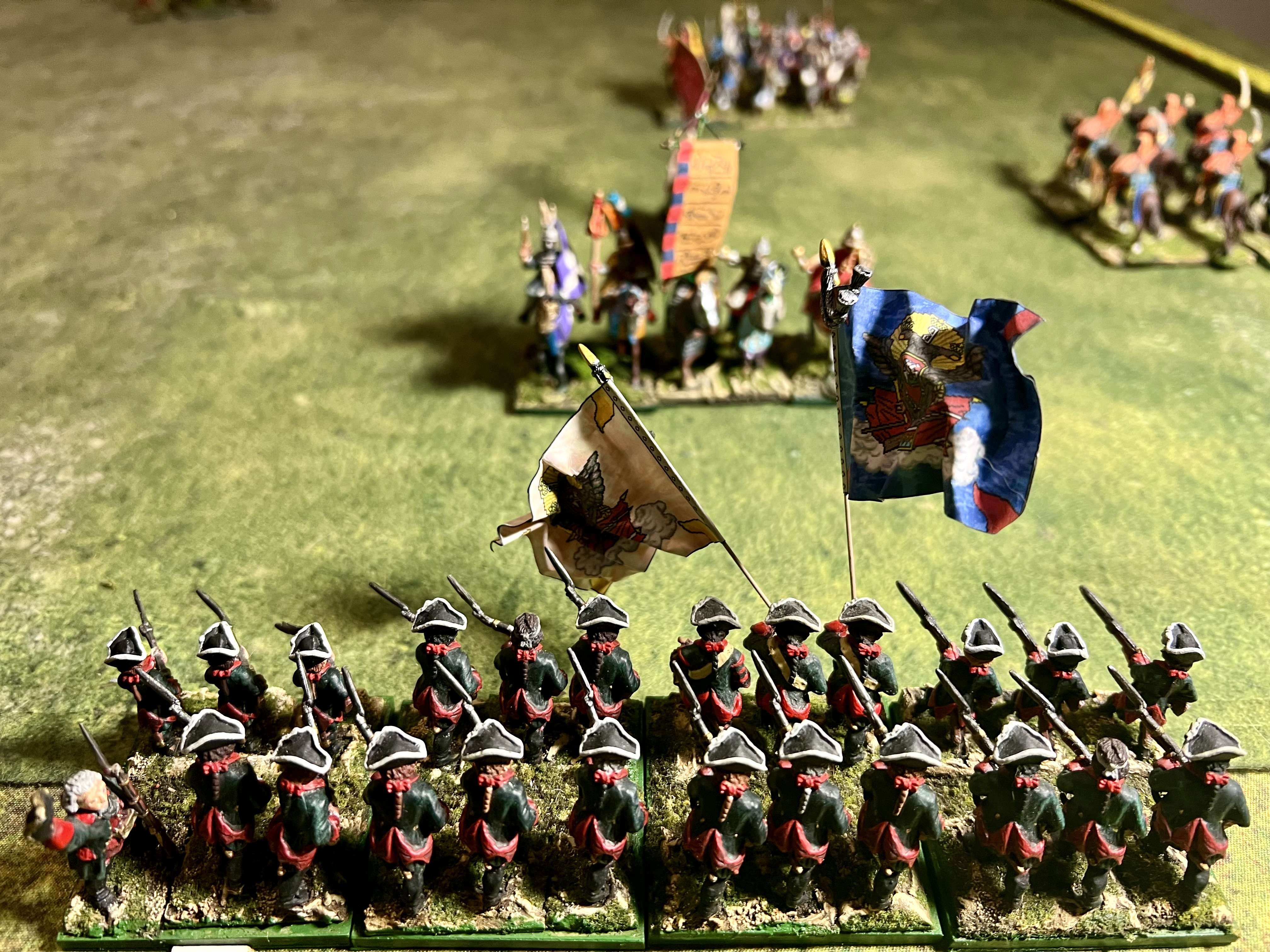Three Ages of Rome (3AoR) is written by UK wargamer Philip Garton for the Helion Books war-games series (published 2022). Garton has a number of ancient and early modern rules to his credit. Even though it is written with massed armies in 6mm and 15mm in mind, I found 3AoR an easy and quick way to play an Ancients battle using my 28mm figures, using the recommended adjust of +50% to movement and ranges for 28mms.
Friday, May 17, 2024
A Battle In Germania: Playing Three Ages of Rome
Three Ages of Rome (3AoR) is written by UK wargamer Philip Garton for the Helion Books war-games series (published 2022). Garton has a number of ancient and early modern rules to his credit. Even though it is written with massed armies in 6mm and 15mm in mind, I found 3AoR an easy and quick way to play an Ancients battle using my 28mm figures, using the recommended adjust of +50% to movement and ranges for 28mms.
Monday, March 25, 2024
First Thoughts on Henry Hyde's Shot, Steel and Stone Miniatures Rules
Not that they are especially new, but I've spent the last few weeks learning a set of horse and musket rules by Henry Hyde called Shot, Steel and Stone (SS&S). I've been looking for a good set of rules suitable for the Seven Years War period, and added SS&S to my shopping cart when I was buying some books on the Caliver website. They are also available on the Wargames Vault webstore, and are fairly inexpensive.
My first impression of SS&S was that the subtitle, "The Bare Essentials", described it well. The black and white book weighs in at about twenty-ish pages but was attractively bound in a soft cardboard cover. The B&W photos show ranks of the old school figures that Henry unabashedly loves, and help give these rules their nostalgic feel. However, Henry's been busy augmenting these rules with a whole set of "how to" videos on his You Tube channel, done in his loquacious and enthusiastic style.
Since I had my Turkish 18th century army on the table (see my previous post here), I decided to put my Russian troops down and have a go. This may have been a mistake, as it's always better to learn a new set of rules with fewer units, but I couldn't resist the visual appeal. As you can see, I didn't put any terrain down, as I wanted to focus on the core mechanics.
Here are four things I especially liked about these rules.
1) Limited Friction. Commanders and subcommanders can have three ratings, basically Good, Average, and Poor, which determine their command radii and the bonuses they can give their troops. However, at the start of each turn, each commander's ability is checked by a die roll, meaning that even good commanders can have a bad moment, and vice versa. This effectiveness check imposes a limited friction on the battle, so that a bad roll means that a commander's units will move more slowly and be less reliable in melee, or (again), vice versa. Thus, a wing of the army will not lose a turn, as in some other rule sets where initiative rolls are required, but that wing might perform erratically to the good or bad.
2) Basing Agnostic. Like other rules sets, bases don't have to be of a certain size as long as the size is standard, and movement and range is measured in base lengths (my bases are generally 2 inch squares, so that's easy to work out). Unit strength is measured by a number of bases. Bases can be removed by shooting hits or by melee results. Large units have better morale than smaller ones, and generally when a unit gets to half its original strength, it's basically spent and will retire. Each base gets so many dice for shooting or for melee.
3) Morale System. In SS&S units have three levels of quality, A (elite), B (line) and C (poor). Morale checks are taken before charging, when being charged, after melee and after shooting hits are taken, etc. The quality of the unit and its size are among a range of factors that determine the morale check modifier, including: unit posture (eg, advancing or retreating), hits taken that turn, current size vs starting size, formation (eg, skirmish vs close order), threats to flank and presence and proximity of supporting units.
That sounds like a lot to calculate, and will remind older players of WRG rules sets and the days of yore, but Henry's supplied a clever little matrix that makes the process fairly easy to work through.
Of course, the dice will be perverse. Here my Elite (A Class) Russian grenadiers caught a unit of Poor (C Class) Ottoman skirmish bow in a charge and amazingly the skirmishers held their ground and fought the grenadiers to a standstill, with casualties tied on both sides. Of course, two of those grenadier bases were newly painted and having their first outing, so the new unit curse naturally applies.
4) Disruptions
Monday, May 22, 2023
Checking into the blog after a busy spell (church work plus a LOT of gardening) to report on a brief game played using Osprey’s Xenos Rampant, the new SF miniatures rules by Dan Mersey. I heard good things about it from my friend James, and since both of us have crossed swords many times playing the fantasy rules Dragon Rampant, I thought it would be fairly easy to learn these rules since I knew the Rampant system. I was right.
Xenos Rampant (XR) is best thought of as a tool kit that allows almost any conceivable SF trope to be modelled using the core Rampant rules architecture of values for Attack, Defence, Armour, Shooting, Morale. The value of the tool kit comes in skills and doctrines that can be purchased for each troop type, and then a further set of “Xenos” skills that can be assigned as the SF trope demands.
In my case, I decided to pit my “Space Kitties” (Khurasan 15mm Tigrid figures), which I think of as Kzinti from the Larry Niven stories, vs humans. I built a decent force of Kzinti-proxies using the Khurasan figures and vehicles from Ground Zero Games, giving me a mechanized platoon with some heavy support. I’ve only recently started working on the human figures, so all I could do was pit one mounted section of cats vs a small section of human Recon Infantry.
One of the first decisions I had to make was whether to take the XR recommendation of converting inches to centimetres for 15mm figures. I decided to keep the units as inches to give greater ranges as befitting future weapons.
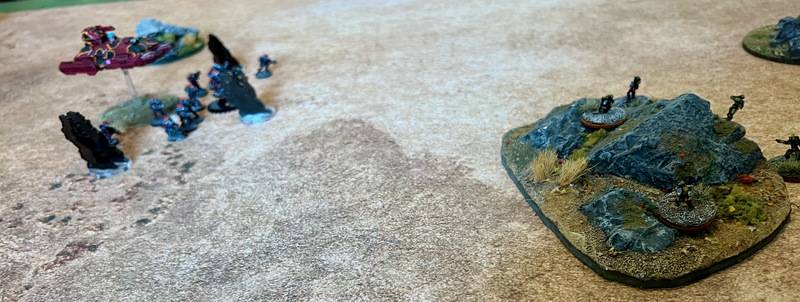
Here a five man section of humans classed as Recon Infantry in XR terms. The figures are from Darkest Sun miniatures and since they are all I have currently painted, I decided to massively upgrade them, giving them the Sniper (no shooting penalties for long range fire), Combat Medic (chances to recover lost figures, basically a Heal spell in Dragon Rampant magic rules), and Fire Support (calling in off board artillery). In rocky ground which is classed as hard cover, they sight a Cat APC and call in fires on it.

The fires have no effect, thanks to bad rolls, and the Skimmer goes to ground and disgorges a ten-strong section of angry Cats. To reflect Larry Niven Kzinti canon, I made the Cats Berserker Infantry with Wild Charge, and gave them the Close Assault Doctrine which favours them in base to base assaults. I also gave them the Mobile skill from the Xenos skills, making these Cats extra pouncy. Not great fans of a firefight, but very fast and deadly in the charge: Banzai Space Kitties!
Here the Cats come under a second salvo of Human Fire Support and take casualties, but still charge into hand to hand combat. Being in bad terrain meant the Humans has a decent chance to stand, which they did, throwing the Cats back with 3-1 losses. In the following turn the human fire proved deadly and broke the Cats morale.
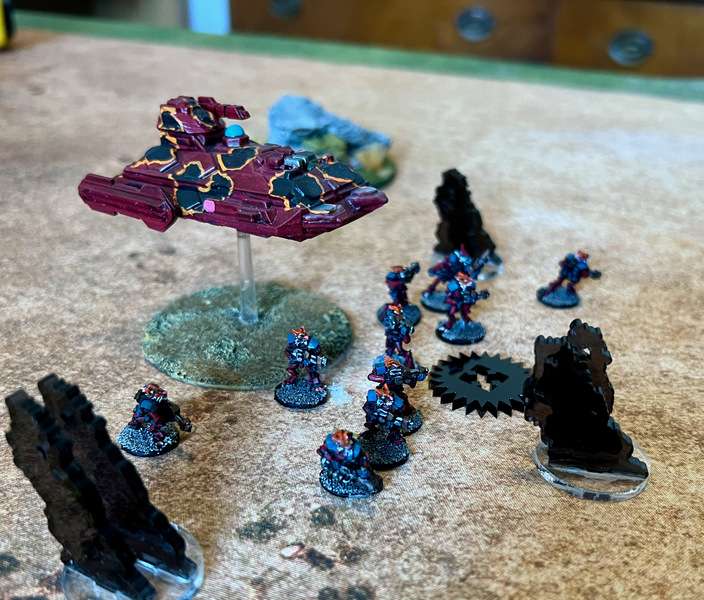
So a good opportunity for a quick look at XR and an incentive to paint more Terran figures and build some more SF terrain, which will mostly have a desert theme for the time being. Good fun to dig out my SF toys and play with them, and hopefully James and I can get together for a chance to dig into XR some more.
Blessings to you die rolls!
MP+
Tuesday, April 11, 2023
#Terrain Tuesday: Warbases MDF Fields and Ponds
Hello friends:
I’ve been quiet here last week, which, as you might expect, was a busy one for my day job as a wargaming vicar, but time to catch up now that Holy Week is concluded.
Recently I needed some custom-made MDF bases and ordered them from Warbases in the UK, as my Canadian supplier didn’t seem to need the business. While I was on the Warbases webstore, I saw that they offered fields and ponds, in a part of the store called Terrain Bases It wasn’t clear to me that these were 2D images printed onto MDF, I had formed the mistaken idea that they were somehow 3D, which was my own misperception.
There wasn’t a full range in stock, but I ordered two field sets, one in spring (left) and one in autumn (right). Here are the large pieces from each set, each with a stone wall and gate around the edges. They blend nicely against my Geek Villain game cloth.

And two small fields in each set, again, spring (left) and autumn (right).
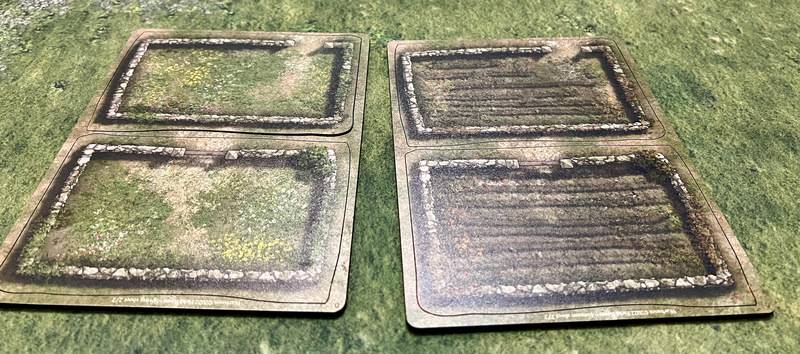
And I bought a set of ponds, which includes a generous five separate ponds.

28mm figure stand for scale.
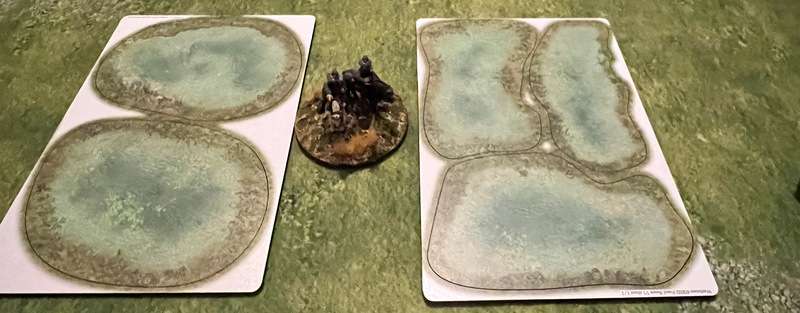
And a 6mm stand for scale. In 6mm, depending on the game scale (eg, Blucher where this one stand would represent a brigade), these would be decent sized lakes!

In 28mm, the large stand would accommodate a four or five based unit quite nicely to represent a terrain objective or a defensible terrain feature, such as a walled field. Useful if one didn’t have enough actual wall section models.
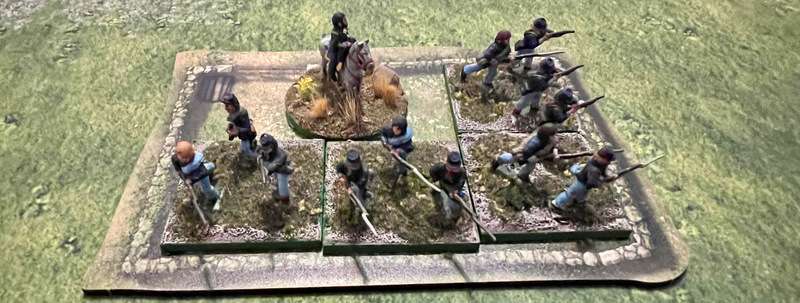
Some folks might balk at the idea of putting 2D terrain representations on the table, which is fine, but for a fast game or if one is travelling light to a club or convention, these models might well be fit for purpose. The quality of the printed images of the field and pond sections is pleasing, so they are a definite step up from fields and ponds of cut felt.
Cheers and blessings to your tabletops.
MP+
Wednesday, December 1, 2021
Getting to Grip with Honours of War
Hello friends:
As I’ve said here recently, the SYW painting muse has captured my attention lately, and her sister muse of SYW gaming paid a visit recently. As I’ve been slowly painting Prussians and rebasing a rather old collection of Russians, I’ve been slowly getting to know Keith Flint’s Honours of War SYW rules, published a few years ago by Osprey.

SYW was one of my early gaming loves, and back in the day the group I hung out with had two favourite rules. The grognards all liked Phil Barker’s Wargamer Rules 1685-1845 (WRG), while the young turks preferred Tod Kershner’s Warfare in the Age of Reason rules (Emperor’s Press). Both were hugely influential rules in their day, and I suspect most people would point to Black Powder as their most prominent heir and successor. I confess I’ve only played BP once and didn’t find it terribly compelling, but can’t offer a fair and comprehensive opinion.
I had been following Keith Flint’s wargames blog for some years and so was tracking his own SYW rules and even received a playtest copy, though at the time my life was complex and my gaming time quite limited, so I put it aside, I was also discouraged by the fact that the National Characteristics didn’t include the Ottomans, as for some reason I’d found myself with a Turkish horse and musket army.
Recently I’ve been rebasing my Russian SYW troops from their WRG-era bases and putting everything on standard size bases, since most rules these days seem basing agnostic and I can’t be bothered cutting fancy and precise bases for skirmishers vs heavy cavalry. I sound like a grumpy old git, but there you go. Feeling that I’d made enough progress to get some troops on the table, I divided my Russians into two forces, each of two very small brigades, just to push some figures around and get a feel for the rules.
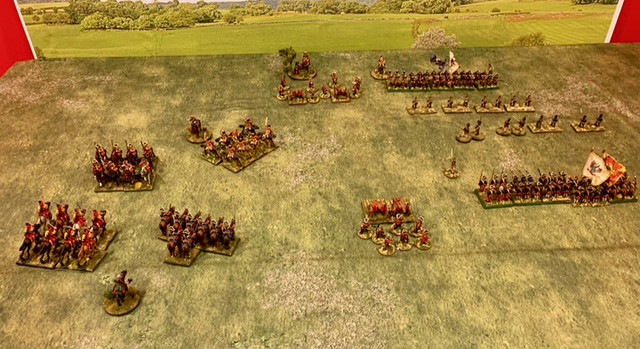
Clearly wanting to modernize their thinking, the Russian army stages a mock battle on the drill fields outside Moscow. Both sides have a brigade of two horse units, and both have a brigade with two batteries, a light infantry regiment, and a line regiment. All units are rated as Standard and all commanders are rated as Dependable, just to make the test drive easier.
In some of the reviews I’ve read, people don’t like the initiative and command and control,system, and others like it. I'm in the latter camp. I liked the uncertainty of which brigade gets to move first, which breaks up the chess-like feel that SYW games sometimes have. I also liked the fact that an average or good commander might get two moves in a turn, vs another brigade’s none, which introduces a very fluid feel.
As others have noted, the game uses the same results table for Fire and Melee combat, which combined with fairly few factors makes it a quick study. Units are rated as Inferior, Standard, or Superior, depending on their troop type and national characteristics. Units suffer degraded performance once they take thee hits from shooting or melee, must retreat at four hits, and are removed from the table at five hits. Here hussars (Front Rank) and my newly painted cuirassiers (Foundry), each already with two hits, collide, each deals three hits, and both units are done. It’s all quite bloody and fast. I might have rated the hussars as Inferior and the Cuirassiers as Superior, just to make it more interesting.
You'll see a bit of a WRG hangover in these bases, as the hussars on the left are based on larger bases to depict light cavalry, while the figures on the right are on the generic 40mm square base that I now use for all my stands.
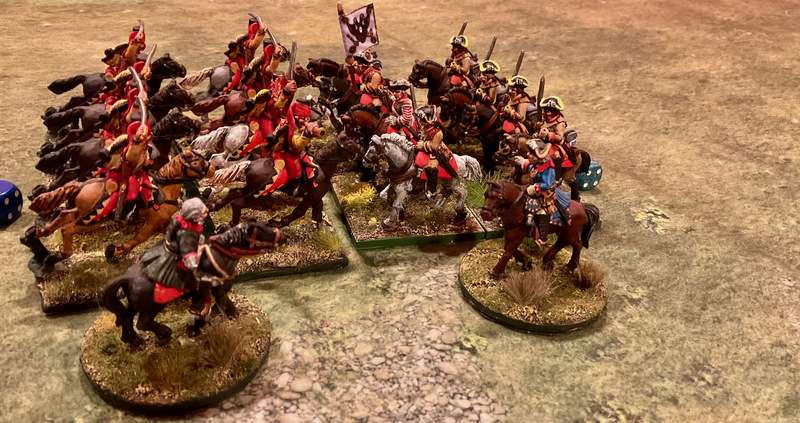
Another feature about the Fire and Melee table is that it uses average dice. I had to beg some off a kind friend, as I'm not mentally agile enough to adjust the dice AND the modifiers in my head. As my friend warned, don't let those average dice get mixed in with your regular d6 dice or you could have poor luck rolling sixes when you need them!
What keeps units on the table is their ability to rally if not closely threatened by enemy units, and especially if close to their Commanding General (a clever mechanic is that each turn players can relocate their Commanding General, which can aid a key part of the battle by increasing a brigadier's performance and helping units in the Rally Phase at the end of each turn. Units with four hits must retire from the fight and reform, which takes time, provided that they are protected by fresh units, which is another nice mechanic.
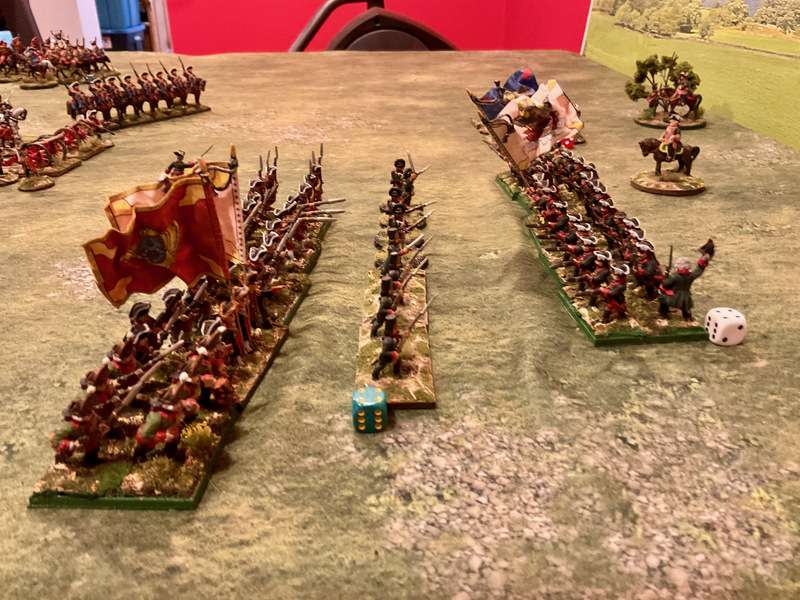
The line regiment on the right in this photo will lose the fight because it’s being whittled down by one of the guns to the left and by the fire of the light infantry. As some players have noted, light infantry can seem unduly powerful in this game, unless one remembers that they should usually be fielded as small units and as Inferior troops, so they shouldn’t be left in the open. Here I had meant to retire the lights through the line infantry on the left, but at the key moment discovered the rule preventing voluntary interpenetration of units if they begin their move within 20cm of an enemy unit. This is why we train, to learn things like this.
Luigi the Catbeast of Muscovy declares ENDEX and all troops return to barracks for extra vodka while their officers must attend a long and tedious AAR conducted by the Observer/Controller staff.

People have been writing reviews about HoW for a few years now so I have little to add that’s new. Quick final thoughts:
- Simple, highly playable rules that still give a convincing SYW feel.
- I like the Command and Control and Initiative Rules, very clever and they give a very fluid feel that would keep players on their toes.
- As others have noted, it’s a game that I think is best played with large numbers of units. With only 6 units a side, as I found, it’s over very quickly and the tactical choices are fairly limited. I think the simplicity of these rules makes them a good choice for larger battles. I’m starting to regret my choice of 28mm for this period, but I’m too far in to go back on that decision.
- These rules are well supported by the author and have their own forum, which isn’t true of all the Osprey blue series rules titles I’ve seen.
I’m pretty sure I’ll have more to say about these rules in posts to come as I get more units on the table.
Blessings to your dice rolls!
MP+
Saturday, September 11, 2021
My Thoughts on Absolute Emperor, New Napoleonic Rules from Osprey
(Note: I had meant to post this on my self-imposed timeline of Napoleonic Thursday, but will have to settle for Saturday evening.)
I had mentioned in a previous blog post that I had taken a flyer on Absolute Emperor (AE), Boyd Bruce’s new Napoleonic rules, published this year in Osprey’s “blue book” rules series. Thanks to my son John, who came out from the west coast to spend the last week of August with his old man, I’ve had a chance to put down some figures and take these rules out on the road. What follows is not a comprehensive review, but some first impressions.

AE does what is says on the tin: it’s a basic, highly playable set of rules for a reasonably sized Napoleonic battle in 2-4 hours, so, a club game. Individual units (called divisions in the rules) are operate within corps, each commanded by a corps commander, which suggests that these are rules written for army level engagements. However, the fact that these individual units can assume a variety of tactical formations (line, march column, attack column, square, un/ limbered, columns of squadrons) makes the game feel like an engagement of brigades, with the maneuver elements being regiments/battalions/batteries. Judging from the examples of actions given by in the designer notes, Boyd Bruce also thinks of this as a regimental/brigade set of rules.
Therefore, the first thing that I would suggest is that the prospective player abandons any thought that these are rules for big battles. I think it would be fair to say that AE attempts to provide a fast and playable war-game that conveys some sense of the Napoleonic battlefield and the tactics involved at the regimental level. How does it succeed in that goal? I would say, moderately well.
My son John put it very well when he helped me try out AE after playing several games of Sharp Practice. “After all the tactics of Sharp Practice, these rules seem very chess-like to me”, he said, which I think is a fair comment about how these rules capture what is often called the Rock Paper Scissors quality of the Napoleonic battlefield.
Here are the quick outlines. Units are rated as Veteran, Seasoned, and Conscript with “Activation” rolls respectively of 3+, 4+, and 5+ on 1d6. Early on p.9, when these Activation ratings are given, the rules explain that these are also the rolls that these troop type need to hit when Shooting and in Combat (Melee). If you miss that explanation, you will roam the rest of the rules in vain to understand how to shoot and fight. Activation rolls are necessary for most units to charge, or for foot to form square when charged by cavalry.
Cavalry are of two types, Light and Line. The only difference I can tell is that Light Cavalry don't get a charge bonus in Combat vs. Line cavalry.
Units in shooting and combat get different numbers of dice depending on their formation, thus a line veteran infantry unit rolls 4d6 in fire combat and hits on a 3+. Infantry in Combat gets 2d6 in Attack Column with a +1d6 Charge Bonus (+2d6 for non-Conscript French if between 1805-1809) so a Seasoned French unit in Attack Column Charging in 1805 gets 4d6 in the first round, hitting on 4+.
Artillery isn’t rated by quality; it generally gets 2d6 when shooting and hits on a 5+ with one dice if at effective range and 5+ hitting with two dice if in close (canister) range.
Units lose a step in quality when they take 5 hits and they are eliminated when they take 8 hits. In Close Combat, after a round of Shooting, whole units can disappear quickly, so the rules feel quick and bloody.
Commanders get varying numbers of Elan points, more Elan points = the better commander. The total number of all friendly commanders' Elan points means that the player with the lower total moves first, then the player with more Elan moves second, this giving the player with the better generals the opportunity to react to the other guys' moves. Shooting and Combat results are simultaneous. Generals can spend one Elan point each turn to either re-roll one die, allow a unit to rally, re-roll an activation, or change their Corps’ orders (more on that later).
That’s a quick overview of the rules, and most of what you need to know to play.
In this photo, John and I are trying out the third of the teaching scenarios included in the rule book using my 6mm figures. My French are on the right, John’s Austrians are on the left. Using the 6/10mm distances for AE, we began with the French just within artillery range (12”) with three batteries forming a Grand Battery (allowed for in the advanced rules), two units of high quality infantry, and a light cavalry unit facing one Austrian battery, one low quality (Conscript) infantry unit, two medium (Seasoned) quality infantry units, and one line cavalry unit. The Austrians have the advantage of defending a Built Up Area, and the French only have 12 turns to win, so it’s an interesting match up.
We had a decision before 12 turns. John deployed his better infantry parallel to the BUA, exposing it to the devastating fire of the Grand Battery, while my infantry and cavalry approached, forcing his infantry into square to hasten they destruction from th French cannon. My other infantry checked John’s cavalry by forming square, thus allowing the rest of my force to drive the Austrians out of the town. We had the rules figured out reasonably quickly and there were some interesting choices to be made, so a tidy game experience.
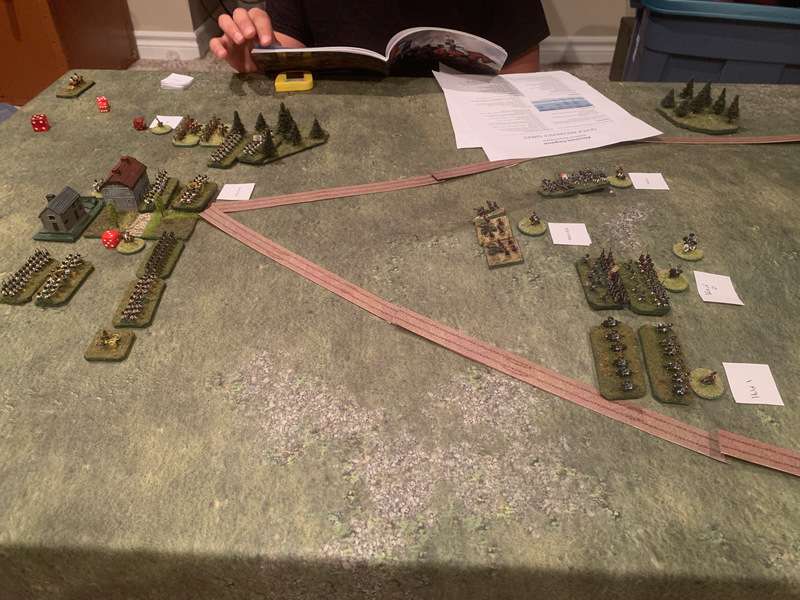
You’ll notice in this first photo that each unit has two bases, one in front of the other. This represented our initial attempt to follow the rules for tactical formation, so that doubled the frontage of foot units when they went from column to line, and then put the two foot bases back to back when forming square. The next time I played the rules in a solo game, I just used single bases to represent each unit, and mentally kept track of the formations (march/attack column, line) without any trouble. The extra stands on the table didn’t really add anything to my experience of the game so I binned it.
In the second game, I used AE's point system to create a smaller Austrian force (two divisions of infantry, one division of light cavalry and one of line cavalry) versus two larger French infantry divisions and one of French light cavalry. The points system uses some national characteristics - French generals are generally better than Austrian generals, which mean that they can command larger divisions. When building my divisions, I immediately noticed that there are no requirements for a player to select poor quality units, no ratios limiting the number of veteran/elite vs seasoned/conscript. Thus, two players could just fight with small numbers of crack units if they wanted to.
Here is the setup for the second game. At first I wanted to make the stream impassable except at the bridges, but that would make for a dull game fought over two chokepoints, so I just made the stream difficult terrain (takes a full turn to cross). The central hill has impassable terrain on the right (shown by the rock markers) but the centre/left can be climbed. The Austrians set up first, holding the stream with their two infantry divisions and the cavalry in reserve to address any breakthroughs.
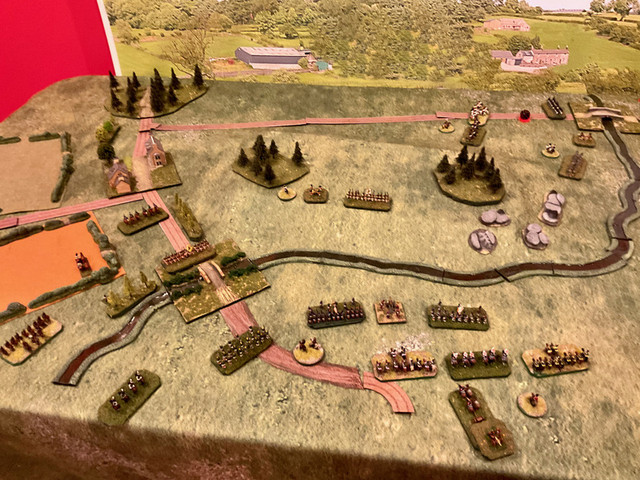
I gave the French on the right two batteries to hasten the chances of a breakthrough and tie up the Austrian cavalry, while the main French effort is on the left wing where the cavalry will support the infantry attack on the hill.
By turn three the game is well underway. In the photo below, the black dice behind the French unit crossing the stream shows hits from the Austrian battery at the top. Two hits in one turn will cause a unit to Halt, preventing it from charging and closing to combat in that turn, unless its commander wants to use a point of Elan to rally it so it can charge in the Combat phase.
You’ll also notice a numbered chit beside the French battery at bottom centre. I like the optional rule in AE giving batteries ammunition limits (4 shots at full strength, 4 shots at half strength and then the battery is removed from play). Otherwise, there is no incentive for the stronger player to not just smash the enemy into submission before going in for the kill, which is essentially how I used my Grand Battery in my first game with my son John.
Also notice the French infantry which has crossed the stream and will then CHARGE the Austrian line cavalry which failed its Activation roll to charge the French foot. Say what? Yes, the rules make no prohibitions against infantry charging cavalry, the deterrent being that if infantry not in square loses a combat with cavalry, then the infantry is destroyed. Well, this is a test game, so I tried it, and the French foot won! True grognards might shake their heads at that.

Having won the Combat, the French infantry sidesteps into the wood on its next move, and allows the lancers behind to move up and finish off the Austrian horse in the next turn. Lancers are Light Cavalry, so don't get a Charge Bonus vs Line Cavalry, but the rules didn't say anything about them getting their Lance bonus in the first round. Therein is seen again one of the contradictions in AE, that a game for Big Battles still gives certain cavalry a weapon type bonus, but I guess the counter argument is why paint lancers if you can't have some fun with them?
With the centre shattered, the Austrians concede the game and begin their withdrawal. Thus, a decisive result within an hour of play (plus another hour of reading and head scratching), which is in keeping with AE’s ethos of a fast game, a laugh, and a pint afterwards.

As you can see from these two battles, it doesn’t take long to figure out the basics, and AE delivers a fast result with a minimum of complexity. I could certainly see it working for a quick game on club night.
What didn’t I like about AE? First, the rules feel hastily written. I’ve already mentioned how the centrality of the Activation numbers is very quickly explained. There are likewise some situations where I could find absolutely no guidance from the rules, particularly in Combat (Melee). What happens when both sides score the same number of hits in Combat? The rules say that if three hits are scored on a unit in Combat, it Recoils from Combat 1” and becomes Disorderd, so if both sides score 3 hits each I guess they both bounce back, but what if both sides only score 1 or 2 hits each in Combat? I scratched my head in vain.
Some people on Twitter defend the author and blame Osprey for a bad job of editing. That may be, but the author does spend a lot of ink on design notes, often beating a straw man of overly complex rules that have burdened Napoleonics in past, and touting his simpler is better philosophy. I would rather he have spent the ink making his rules clearer.
The Orders system likewise is interesting but ultimately seems unnecessary to me. Corps can be ordered to Attack or Defend (fairly obvious), Hold (sit tight a set number of turns until they Attack something), Flank March (one order per side per game), or Retreat. First, in a game system that boasts of being easy to play, an Orders system that hearkens back to the Naps rules of the 1980s and 1990s feels like a wrong turn. Most of these Orders are obvious, and if one wanted to write overly specific orders (eg, attack the woods to the north of the village), that would be more detail than the spirit of the rules would seem to tolerate. Again, there are also some ambiguities. Does a Flank March automatically succeed once the specified number of elapsed turns is reached? Do the units in a Flank March appear anywhere on the specified flank of the table? The rules suggest yes, the flankers appear where you want, when you want, as long as the turn number is written down ahead of time. That would have made Grouchy’s life easier at Waterloo!
Finally, I wanted to like the Elan rules, and while it can be useful to take a re-roll or allow a unit to ignore a Halt result before a critical charge, I sometimes found myself forgetting the commanders altogether. One could make them more vital with a house rule saying that units can only move if within command range of their Corps Cdr or their CinC.
I don’t want this review to seem harshly critical. I commend Boyd Bruce, and anyone for that matter, for writing a set of rules and then for getting someone like Osprey to publish them. AE would be a quick way to get a player new to Napoleonics into their first game and have some fun doing it. It’s thus a useful entry into Naps wargaming, and could b adopted for fast pickup games when players can’t decide on more complicated rules systems.
For me, I found AE to be less than fully compelling. If I wanted a crunchier rule system with some tactical considerations, with more experienced players, I’d consider Sam Mustafa’s LsSalle or Dave Brown’s General d’Armee. If I wanted a set of rules for big battles where the units truly were Corps and Divisions, I would probably choose Mustafa’s Blucher.
All that being said, Absolute Emperor gets half a Mad Padre blessing.
There are lots of blog posts on AE out there: here’s another perspective.
Cheers,
MP+
Monday, April 12, 2021
Revisiting 6mm With General D'Armee
There was a while back around 2012 when this blog was buzzing with excitement about my foray into 6mm Napoleonics. I had purchased a large collection of painted Austrian and French figures, bought some new figures from Baccus, and was learning to paint them. I had picked up Sam Mustafa’s Blucher rules and had played a few games with them, and was generally happy with my progress. Then a move, my wife getting sick and dying, a new duty assignment, retirement from the military, remarrying and starting a new life. A lot of things got in the way, and I think the resurgence of my interest in this period and scale has to do with being in the happiest place I’ve ever been in my life. Funny how it all works.
This Easter seemed like a good time for a wargaming vicar to live out the resurrection by raising my 6mm collection out of their boxes and taking Dave C. Brown’s General d’Armee rules for a spin. I had previously played Dave’s ACW rules Pickett’s Charge (PC) and liked them, and found the mechanics similar enough that GdA was fairly easy to pick up.
I decided the the best way to learn the mechanics was to take two identical forces, thus, a French division of three infantry brigades, four batteries, and a light and heavy cavalry brigade faces its Austrian mirror image. All units were rated as Line for simplicity’s sake. This force selection seemed to promise enough complexity to get a sense of rules that claim to be scaled from Divisional to Corps level.

The Austrian force of General Albert Kurvi-Tasch (dubbed by Archduke Franz Joseph “More moustache than brain”) defends the key crossroads south of the village of Schlumpen and watches as the French of General Theodore d'Ordure, dubbed by Napoleon as “the Grossest of the Gross”, comes into view. The backdrop is not 6mm, sorry about that.
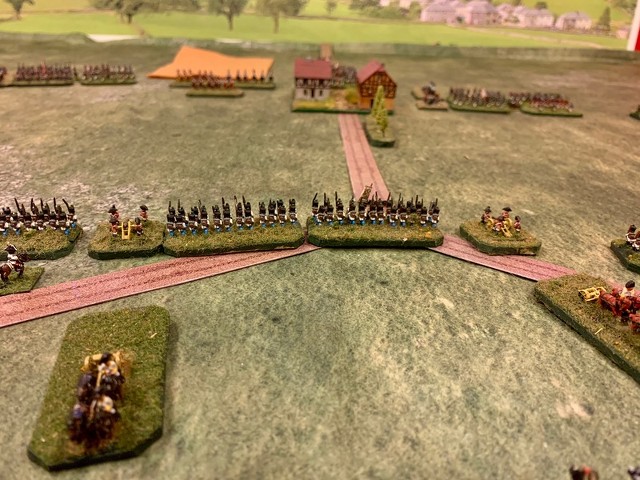
The battle began with the light brigades of cavalry scrimmaging on the Austrian right. Dave’s charge procedure rules were basically familiar to me from PC and are fairly simple to administer in horse on horse actions, where there is no defensive volleying to complicate things. At first things went fairly evenly, with the two brigades somewhat battered and retiring to reorganize. When the went at it again, however, the Charge dice went disastrously for the French: their “2” vs the Austrian “12” on 2d^ (it’s all d6 based) saw the French light horse simply dissolve. Charges can be exciting and tempting because you never quite know how they’ll go.
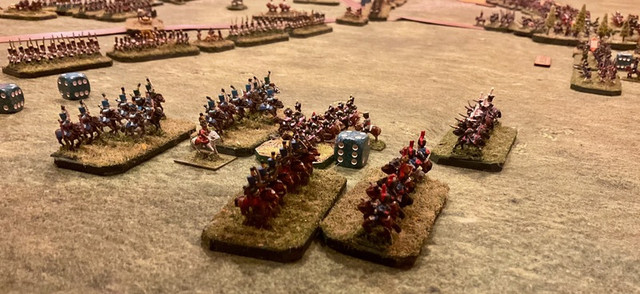
The French reserve advances through Schlumpen in a brigade column, hoping to punch a hole through the Austrian centre with the support of the heavy cavalry to their left and the two flanking infantry brigades. As you have noticed by now, I am using small dice to keep track of casualties, though am not happy with the look. Perhaps I need micro-dice? I’m now wishing my unit stands had little slots for casualty dice like the cool kids have.
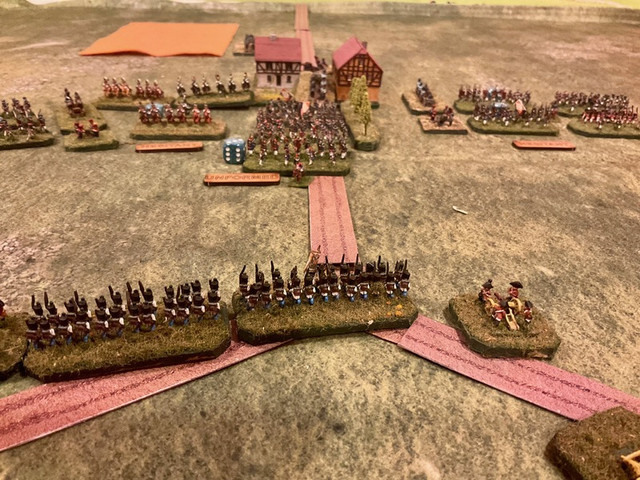
Artillery can be deadly in these rules. The two Austrian batteries in the centre have savaged the lead unit in the assaulting brigade, and checked its advance. Ordure moves his heavy cavalry forward to open the way, and the Austrians respond. It’s still anyone’s battle.

Austrian cuirassier and French dragoon trade blows, largely ineffectually, and the two brigades basically repel one another like bumper cars at a fairground. For me this is where 6mm really shines as a visual scale with the clash of massed units. I would never paint enough larger figures in my remaining lifetime to achieve the same effect.
Speaking of visual appeal, I’m quite happy with the table. The game is being fought on a Geek Villain 6 by 4 fleece Grasslands mat, the roads are from Paper Terrain (glued to cardboard and then cut out) and the buildings are by Timecast which I really like.

In the final clash of the game, the French columns advance on the Austrian lines. I’m very happy to say that the two French infantry units in the centre are the first 6mm figures I ever painted, almost a decade ago now, and I’m very happy with the way they look. At this point you may be wondering how I portray formations. Good question.
All my units are based the same, in lines, though with French units I usually put some skirmishers in front. However, because in my world a single base represents a single unit, I don’t have any way to represent the formation changes that GdA and other rules call for. My core assumption then for this game is that each unit is currently in the formation that makes sense fir the situation and for its army doctrine. Thus, here the French are in column and the Austrians are in line. Infantry, if charged by cavalry, would go into square if they made the appropriate test. Cavalry are generally in column. I have enough limbers (another benefit of 6mm) to portray artillery either limbered or unlimbered. It seems to work so far.
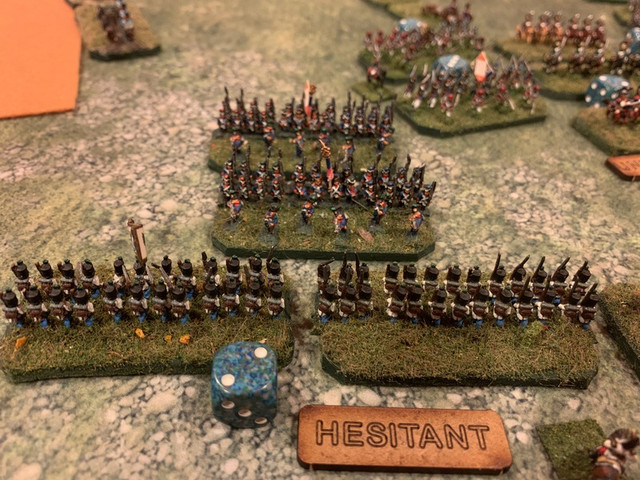 \\
\\
With the repulse of the French infantry (as in Dave’s ACW rules, defensive fire from an intact foe is pretty deadly), and with the destruction of the French light horse, the game seemed to be done and an Austrian victory.
One of the features of Dave’s rules that I especially like is command and control. As in PC, GdA uses a varied number of Aides de Camp each turn to help ensure that your brigades do what you want them to do, and reduce the chance that they might go Hesitant and spend a turn dithering in uncertainty. ADCs can help you salvage wavering brigades, can direct artillery in intensive bombardments useful to prepare for a charge, etc. In this game the French could have 5 ADCs a turn to the Austrian 4, but you then have to roll for their availability each turn, so you seldom have enough, which adds some uncertainty and friction - no wonder Richard Clarke and TFL rep Dave’s rules, they are a natural fit with the TFL philosophy.
I look forward to revisiting GdA soon, preferably using an historical battle as the template. I just finished using CCN to fight Wertingen, the Austrian defeat at the start of the 1805 Ulm campaign, and that seems a manageable sized battle to fight.
Thanks for reading. Blessings to you tiny soldiers!
MP+
Monday, April 5, 2021
In Praise of Paper (Terrain)
Reading the Canadian historian Mark Zuelkhe’s book on Operation Husky, the Canadians in the Sicilian Campaign of 1943, got me thinking of using some of my 15mm kit to explore that campaign, and to do so I would need some Italianate buildings, enough for a small town. So I turned to a tried and true source, Paper Terrain, run by Scott Washburn, and ordered his Italian Village pack and his Town Expansion set. Here’s an example of one of the sixteen buildings that came promptly in a flat manilla envelope.
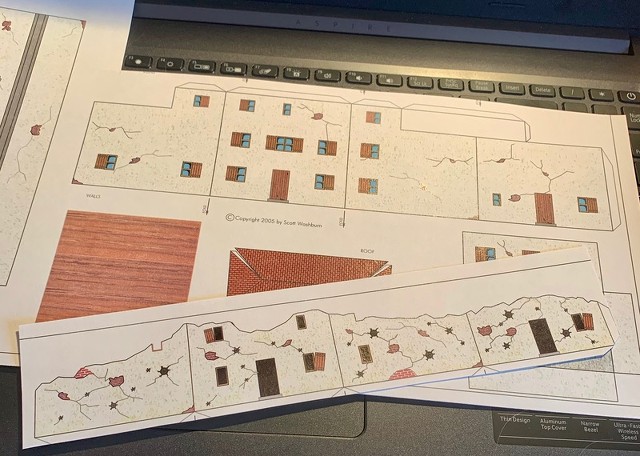
It may look daunting, but all you need is a steady hand, some patience, a decent pair of scissors and a craft knife, and a patient partner who can put up with the myriad bits of paper that are the byproduct of the assembly process. I used a metal ruler and craft knife to lightly score the fold lines, and while the buildings are printed on sturdy cardstock, you need to learn not to score the lines too deeply. Once cut and scored, you fold them together carefully and glue them. I use white carpenter’s glue.
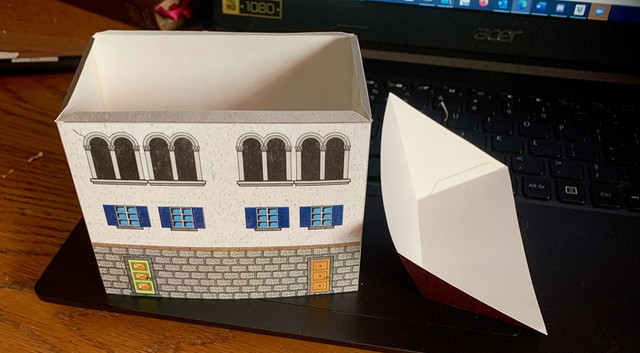
As they say, some assembly required. Putting the roofs on is perhaps the trickiest part but you soon get the hang of it.
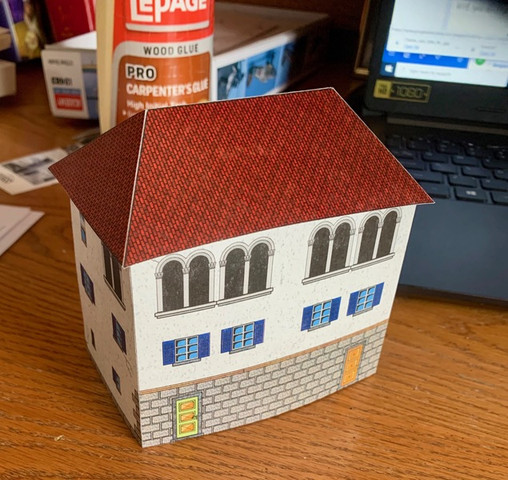
Each building includes a ruined shell which nests in the completed building like a Russian doll set. Very useful once the HE starts flying. I suppose you could dress the interior with rubble, but keeping it clean makes it easier to place stands of occupying troops.
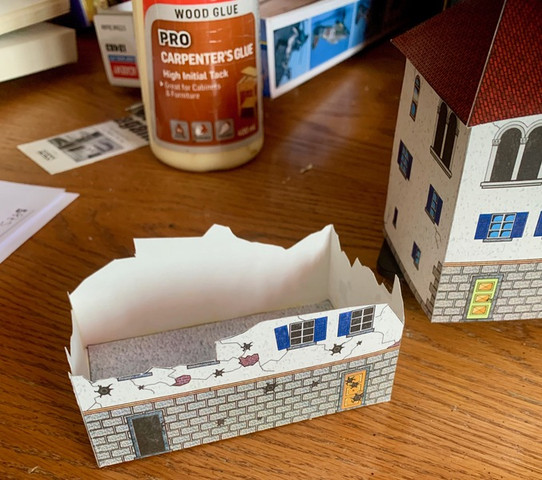
Some of the completed buildings, laid out on my Sicily fabric terrain sheet from Geek Villain, which is a nice piece of kit in its own right. The church is stunning and large.
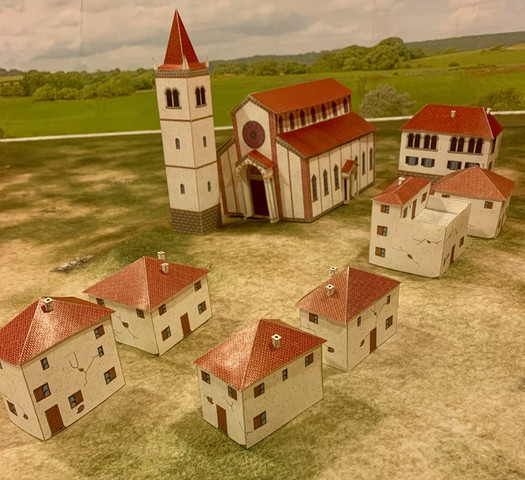
The buildings look good on their own, but they look even better when based. I am working on two Italian building bases now, using the garden walls and sheds that Scott includes with his terrain sets, and I will show the finished results in another post.
I have several sets of PT products - a Western European town set suitable for France in 1944-45, a Northern Russian village set suitable for the Ostfront or even the black powder era, and now these Italian buildings. I’ve found Scott to be easy to deal with, and quick to answer questions about tricky points of assembly (which are rare in my experience). In my last email exchange, he mentioned that he keeps expecting resin and 3D printed terrain to put him out of business, but demand remains strong. For me the advantage of his product is that it’s relatively sturdy if carefully stored and handled, comes in a variety of scales, does not require painting, and provides an affordable mass of terrain in relatively little prep time.
Blessings to you scissors!
MP+r
Thursday, March 11, 2021
Quick Look at Five Men in Normandy, Nordic Weasel's WW2 Skirmish Rules
Hello friends:
Just putting a few words of praise here for Five Men In Normandy, 30 Cal Edition, a cheap and cheerful set of skirmish rules by Nordic Weasl for very low (squad/section) level infantry actions in WW2. I’ve been following @weasalnordic on Twitter for a while, he runs a solo game design business and is quite prolific. I was originally interested in his SF rules but 5 Men was cheap and looked like just the thing for a simple game that was easy on the brain.
Here five Canadians are tasked with securing a ruined building to use as an OP post. They have one sniper rifle, one Bren, one rifleman with an SMLE, a corporal with a Sten, and an officer with a pistol. The ruined building is held by four Germans, a two man LMG team, a rifleman, and an NCO with an SMG. All weapons randomly assigned.

The German defenders.
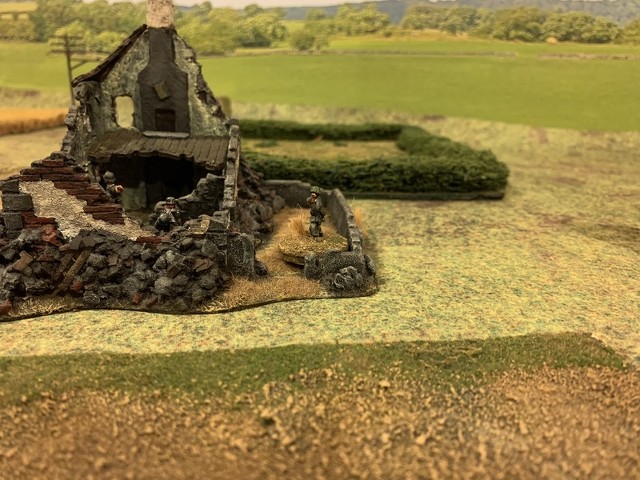
The Canadians got a map as a random asset, so they were able to sneak into initial positions. From there, it was fairly straightforward real world tactics, with the sniper and the Bren keeping heads down while the thee others moved into grenade range. The Germans took two casualties and the survivors elected to slip away.
You can find these rules in Nordic Weasal’s section of Wargames Vault to purchase as a PDF download. As I said, these are very simple, D6 driven rules, ideal for very small actions with a cinematic feel. No armour or offboard infantry, just a few guys running around with infantry weapons. You could teach them to someone in less than five minutes, and I could see my grandkids giving them a go as they get a few years older. If you want complexity, then look to a system like TFL’s Chain of Command.
It was also fun to get out my 20mm toys after a year in their boxes and to try out some photos against my new model railroad backdrop, which probably needs its own post.
Blessings to your die rolls!
MP+
Wednesday, May 8, 2019
Wednesday Wargame: Putin Strikes
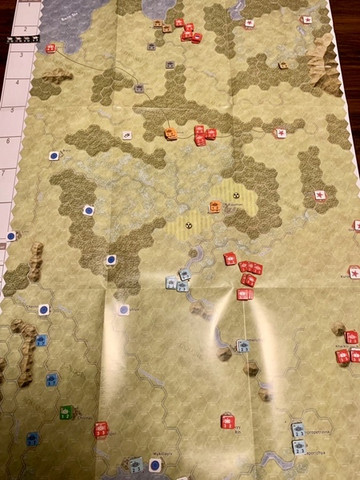
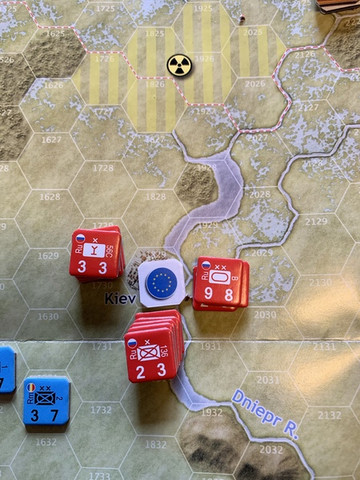

Thursday, May 2, 2019
Meanwhile, In Rohan - 6
Revisiting my never-ending Lord of the Rings interest here and a brief return to Rohan, where housing starts are up.
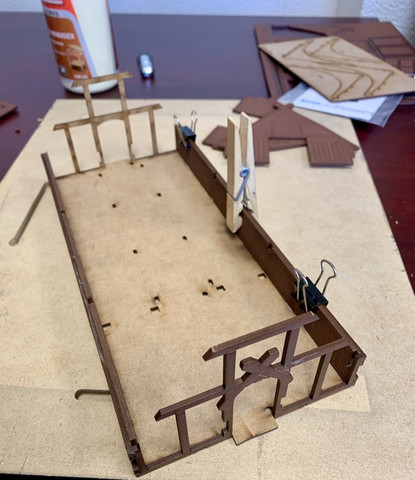
This is the 4Ground Viking Trader’s Shop which will make a splendid addition to the Rohan village I have been working on for the last few years. I suspect it will attract some Uruk-Has raiders in search of plunder, and will need to be stoutly defended. And I know just the chaps for the job.
Also on the painting bench are some aspiring Riders of Rohan. These are Goth Heavy Cavalry from Footsore Miniatures.
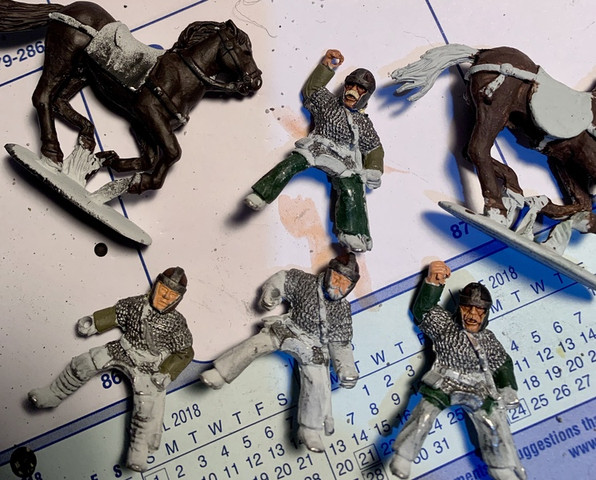
Pros: The figures are metal, and so are the horses, so I won’t have the problem I have with the blasted Games Workshop plastic horses breaking off at the legs when clumsily handled on the table. Also, they look suitably Rohanish with their long hair, beards and moustaches, and generally simple accoutrements. They don’t match perfectly with the GW Riders figures, but I have long since decided to build LOTR forces with figures from whatever range I please, so nyah boo to you, GW.
Cons: These figures came with a considerable amount of flash, which involved laborious scraping and filing of men and horses. Also, while they came with round shields (not shown), I forgot to order weapons, so I ordered a pack of javelins from Northstar. Also their gripping hands were solid, so I had to carefully drill them out so the javelins will fit. Finally, they don’t have capes or bows, as the GW Rider models all do, and while I could model them with green stuff, I’m not currently so inclined, so they will serve the Riddermark as they are.
Bottom line: while I was quite excited to order some Footsore minis, and will no doubt order more, I give these figures between a B+ and an A- at best.
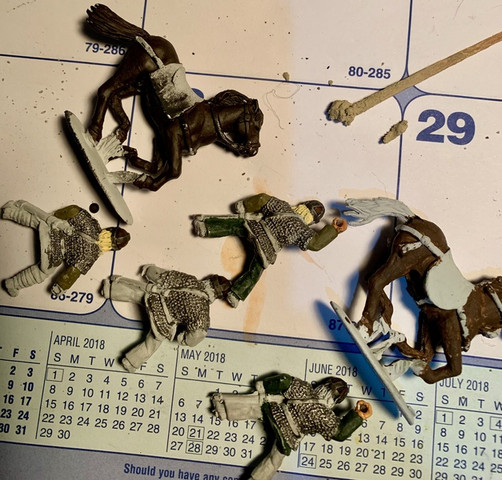
I have a quiet weekend ahead, so I am hoping to get a push on and ride these fellows off the table soon.
Blessings to your brushes!
MP+



